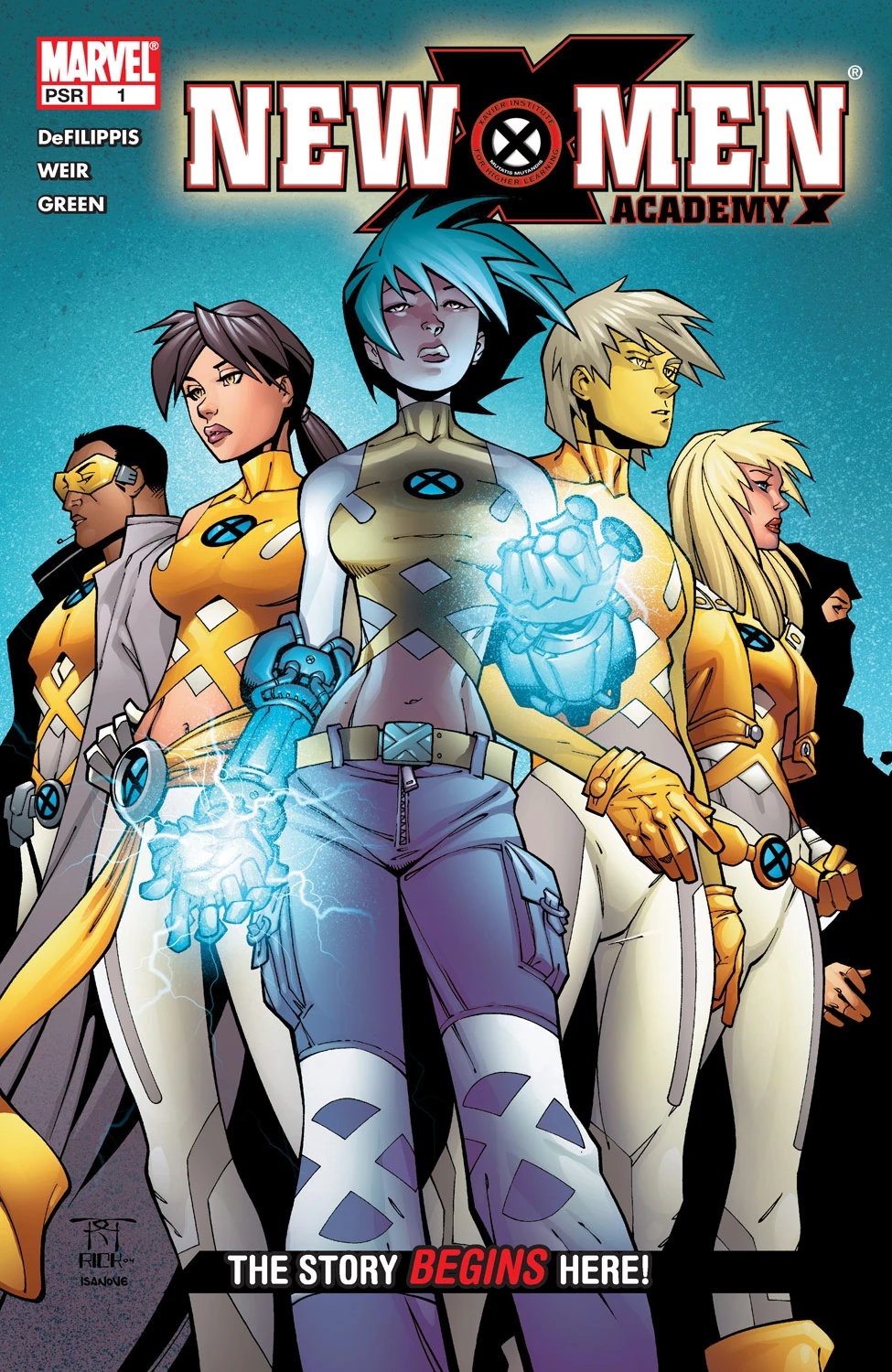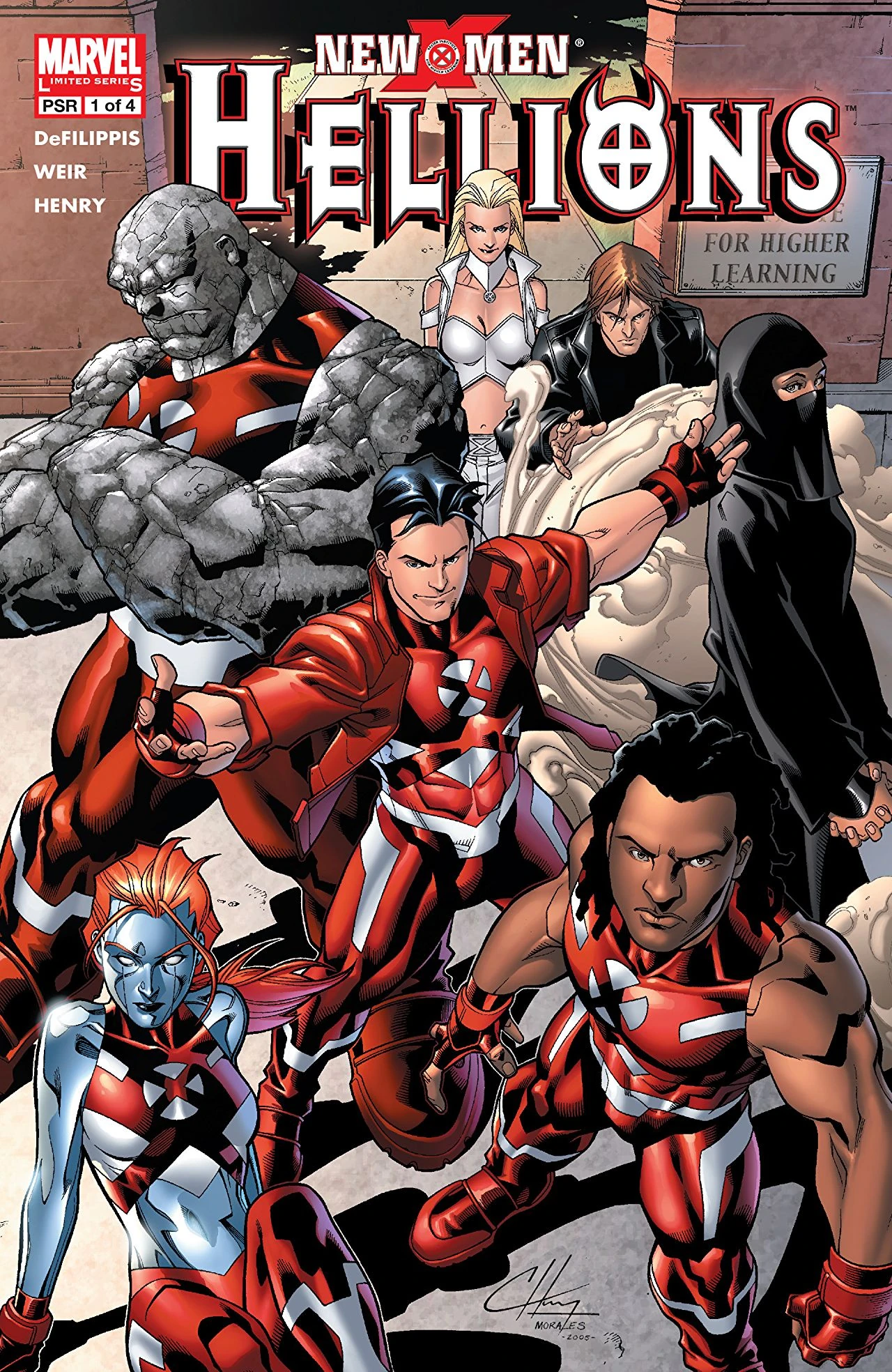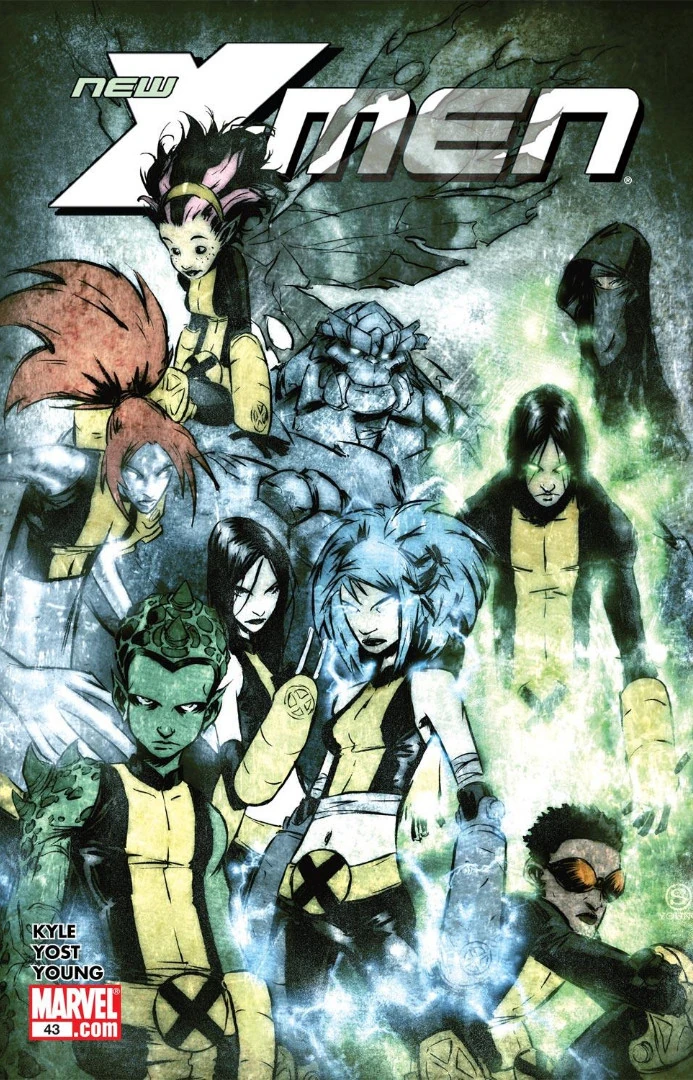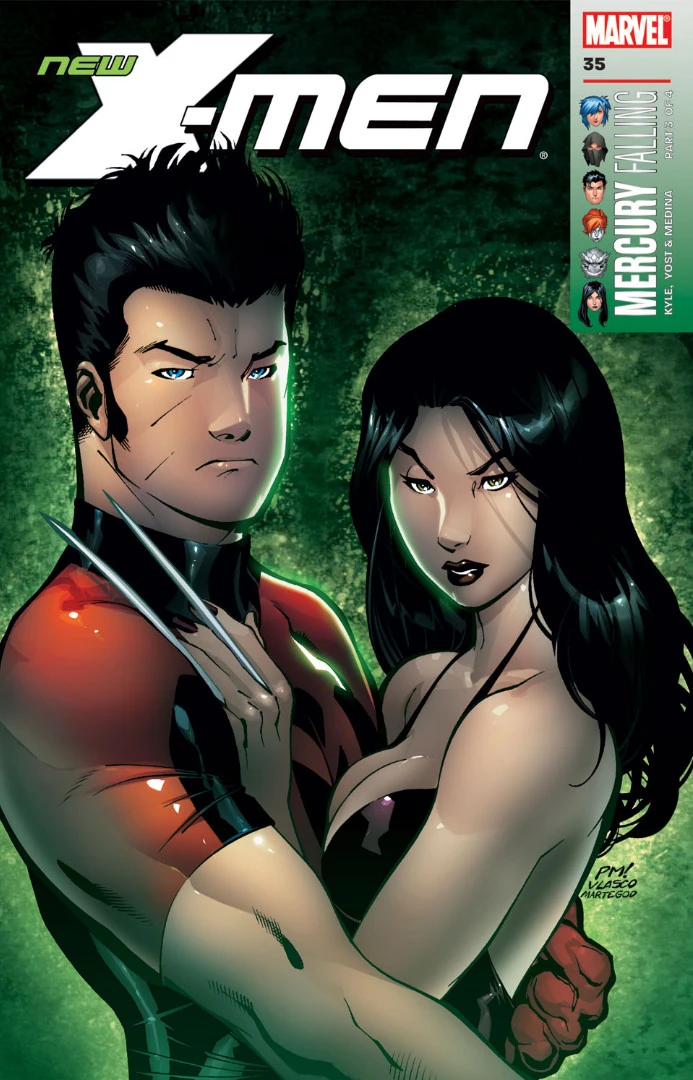Following my read-through of the early years of Laura Kinney, I decided to read about her time at the Xavier Institute, learning alongside other teenage mutants. I decided to read the entire New X-Men series (of which Laura joins the cast halfway through), as well as the New Mutants maxi-series that led into it.
For this post, I read the following comics:
Follow @C_Andrew_H
For this post, I read the following comics:
- New Mutants 1-13 (by Nunzio DeFilippis and Christina Weir, 2003-2004)
- New X-Men 1-46 + Yearbook Special (by Nunzio DeFilippis. Christina Weir, Craig Kyle, and Chris Yost, 2004-2007)
- New X-Men: Hellions 1-4 (by Nunzio DeFilippis and Christina Weir, 2005)
- The X-Men: Messiah CompleX crossover event, which in addition to New X-Men 44-46 (above) includes the following issues from 2007-2008:
- X-Men: Messiah CompleX one-shot (by Ed Brubaker, 2007)
- Uncanny X-Men 492-494 (by Ed Brubaker, 1963)
- X-Factor 25-27 (by Peter David, 2005)
- X-Men 205-207 (by Mike Carey, 1991)
I read all of these on Comixology. Though I bought and read New X-Men for the first time years ago, the Hellions miniseries and New Mutants only became available digitally recently, so this was my first time reading those titles. Note that this is different from the much more famous New X-Men series that Grant Morrison and Frank Quitely did in 2001-2004.
Story:
New Mutants and New X-Men tell the story of teen mutants, all of which are new characters. They find each other and the X-Men, and learn about their own powers, as well as the consequences of being a mutant: being hated and feared by normal humans. Noriko (Surge) is a street kid who uses pills to control her electricity powers, until the X-Men give her special gauntlets to control them. Everything Kevin (Wither) touches decays and dies; he accidentally killed his father when his powers manifested. Laurie (Wallflower) generates pheremones that make people feel the way she feels, and sometimes has a hard time controlling it. Her best friend Sofia (Wind Dancer) controls the wind, and helps keep Laurie's pheremones in check. David (Prodigy) is the smartest kid in any room, as he suddenly knows anything other people in the room know. He was denied admission to Harvard, as the university can't guarantee the safety of alumni of Xavier's. Josh (Elixir) hung out with bigoted, anti-mutant kids, but his friends cast him away when his healing powers manifested.
 |
| New Mutants squad, on the cover of New X-Men #1. Image from Marvel Wiki. |
These kids become the New Mutants squad in the newly-reopened Xavier Institute. They instantly become rivals with another squad, the Hellions, led by hothead telekinetic Julian (Hellion) and including Cessily (Mercury), Sooraya (Dust), Santo (Rockslide), Brian (Tag), and Jay (Icarus). Despite being jerks, the Hellions appear more supportive of Wither as he is asked to answer for the death of his father. Wither and Icarus switch teams, and the animosity and romantic tension among the teen squads continues to rise through the school year.
 |
| Hellions squad, on the cover of New X-Men: Hellions #1. Image from Marvel Wiki. |
After the House of M crossover (for which issues 16-19 were a tie-in story and issues 20-23 were tie-ins to the aftermath event, Decimation), fellow mutant Scarlet Witch eliminates the X-gene in the vast majority of mutants, making them human. This affects most of the students at Xavier's, and many are killed in an attack by the Purifiers, an anti-mutant hate group. The Purifiers blow up a bus full of depowered mutants (including Tag) and also murder Icarus, Wallflower, and Quill.
The surviving students are regrouped into one squad, which includes new members, the first being Laura (X-23), and later Victor (Anole) and Megan (Pixie). They must face off the Purifiers, a Nimrod Sentinel from the future, and the demon Belasco in his hunt for Illyana Rasputin (Magik).
The series ends when the Xavier Institute is destroyed during the major crossover Messiah CompleX. The adventures of some of the teens continue on in Young X-Men or other titles (Pixie's adventure continues in Uncanny X-Men, for example, while X-23 goes to X-Force). Others still will be rarely seen from here on out.
The surviving students are regrouped into one squad, which includes new members, the first being Laura (X-23), and later Victor (Anole) and Megan (Pixie). They must face off the Purifiers, a Nimrod Sentinel from the future, and the demon Belasco in his hunt for Illyana Rasputin (Magik).
The series ends when the Xavier Institute is destroyed during the major crossover Messiah CompleX. The adventures of some of the teens continue on in Young X-Men or other titles (Pixie's adventure continues in Uncanny X-Men, for example, while X-23 goes to X-Force). Others still will be rarely seen from here on out.
Thoughts:
Generally, I think the best X-Men books are the ones featuring younger casts. Whether it's the original X-Men run, any run of New Mutants, Generation X, New X-Men, Young X-Men, Wolverine and the X-Men, or All-New X-Men, any title where the main characters are students at a school works for me. I think this is because the mutant metaphor works very well in combination with teen characters. Mutancy develops during puberty, and the upsets it creates can be similar to the feelings experienced by young people during adolescence. It's also when young people might discover they're of a sexual minority (being a mutant as a metaphor for being gay is fascinating as well).
The teens in these books have to learn how to control their own powers, deal with a world that hates and fears them, and on top of that still go through everything normal teens must deal with, like school, rivalries, bullies, and romantic tension. The various love triangles between Wither, Wallflower, Elixir, and Wolfsbane (one of the original New Mutants and a faculty member) is very fun to read. The dynamic between Hellion and Wind Dancer (crushing on one's rival) is great too. Surge and Dust are roommates who disagree on almost everything, and when most of the student body leaves, Surge seeks a room for herself while Dust rooms with the quiet X-23. It is unfortunate that much of this dynamic goes away when many key characters are depowered or killed.
After the Decimation and the new status quo, the series continues to be about teen angst and relationships, but it also becomes much darker. The return of Rev. William Stryker as a villain made for a tense read as many of the characters get murdered. Characters from this period, including the Purifier assassin Matthew Risman and the damaged Nimrod Sentinel play key roles in later stories.
Laura Kinney (simply as Laura X) became part of the cast post-House of M. She had already appeared in issues of X-Men and Uncanny X-Men, and her origin story had already been told. Her education alongside other mutant teens was the next logical step. Seeing her work with others, make friends (especially Mercury and Hellion) and rivals, and look to become part of a team was all quite fun. Some of her relationships in this title will go on to inform her actions in the X-23 ongoing series (which I'll be reading soon as part of my X-Men chronological read-through).
I liked how the new characters were slowly introduced, one at a time in New Mutants, allowed us to slowly get to know them and slowly build the tapestry of the new world in which these characters are finding themselves. The change in title to New X-Men (when the school was reopened and the students were organized into squads) was a good indicator of the change in direction.
I loved the art on these books, though the art team varied throughout the series. I found the styles earlier in the series to be better, with the characters looking more consistent and generally age-appropriate. Later artists, especially Paco Medina (in particular in issues 30-31 and 32-36) and Humberto Ramos (issues 44-46) had a tendency of oversexualizing the teen girls, showing them with large breasts and lots of cleavage or torn shirts. Others, like Skottie Young (issues 38-43), avoided this trope.
As I've said before, I think the best X-Men books are the ones that have younger casts. New Mutants and New X-Men, especially pre-House of M, had a fun dynamic with a great cast of characters, some of whom remain among my favourite X-Men. I'm sad that characters like Surge, Pixie, and Mercury are so rarely seen these days (others, like Anole, Hellion, and Rockslide, are seen more frequently). I strongly encourage anyone who likes X-Men books to pick these up.
 |
| New X-Men squad post-Decimation, on cover of New X-Men #43. Image from Marvel Wiki. |
The teens in these books have to learn how to control their own powers, deal with a world that hates and fears them, and on top of that still go through everything normal teens must deal with, like school, rivalries, bullies, and romantic tension. The various love triangles between Wither, Wallflower, Elixir, and Wolfsbane (one of the original New Mutants and a faculty member) is very fun to read. The dynamic between Hellion and Wind Dancer (crushing on one's rival) is great too. Surge and Dust are roommates who disagree on almost everything, and when most of the student body leaves, Surge seeks a room for herself while Dust rooms with the quiet X-23. It is unfortunate that much of this dynamic goes away when many key characters are depowered or killed.
After the Decimation and the new status quo, the series continues to be about teen angst and relationships, but it also becomes much darker. The return of Rev. William Stryker as a villain made for a tense read as many of the characters get murdered. Characters from this period, including the Purifier assassin Matthew Risman and the damaged Nimrod Sentinel play key roles in later stories.
Laura Kinney (simply as Laura X) became part of the cast post-House of M. She had already appeared in issues of X-Men and Uncanny X-Men, and her origin story had already been told. Her education alongside other mutant teens was the next logical step. Seeing her work with others, make friends (especially Mercury and Hellion) and rivals, and look to become part of a team was all quite fun. Some of her relationships in this title will go on to inform her actions in the X-23 ongoing series (which I'll be reading soon as part of my X-Men chronological read-through).
 |
| Laura (X-23) and Julian (Hellion), on the cover of New X-Men #35. Image from Marvel Wiki. |
I liked how the new characters were slowly introduced, one at a time in New Mutants, allowed us to slowly get to know them and slowly build the tapestry of the new world in which these characters are finding themselves. The change in title to New X-Men (when the school was reopened and the students were organized into squads) was a good indicator of the change in direction.
I loved the art on these books, though the art team varied throughout the series. I found the styles earlier in the series to be better, with the characters looking more consistent and generally age-appropriate. Later artists, especially Paco Medina (in particular in issues 30-31 and 32-36) and Humberto Ramos (issues 44-46) had a tendency of oversexualizing the teen girls, showing them with large breasts and lots of cleavage or torn shirts. Others, like Skottie Young (issues 38-43), avoided this trope.
As I've said before, I think the best X-Men books are the ones that have younger casts. New Mutants and New X-Men, especially pre-House of M, had a fun dynamic with a great cast of characters, some of whom remain among my favourite X-Men. I'm sad that characters like Surge, Pixie, and Mercury are so rarely seen these days (others, like Anole, Hellion, and Rockslide, are seen more frequently). I strongly encourage anyone who likes X-Men books to pick these up.
Comments
Post a Comment